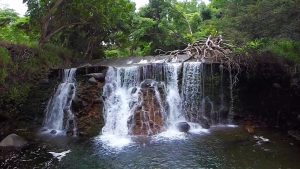For Kaua’i and Maui, landmark decisions on water issues
Posted on Apr 24, 2018 in FeaturedSometimes the best decisions come when people work together to find solutions. That was the case on Kaua‘i and Maui when the subject was water and the key stakeholders resolved to find solutions to water allocations without years of contentious court battles.
“It totally took Governor Ige’s and this administration’s focus on resolving water issues proactively — establishing meaningful in-stream flow standards and balancing uses in a positive way,” said DLNR director Suzanne Case. “The decisions changed how we operate — from being tied up in litigation for 15 years and instead trying to resolve things through a much more inclusive process.”
In the Kaua‘i case, a mediated settlement approved by the Hawai‘i State Water Commission last year, immediately restored continuous flows in West Kaua‘i’s Waimea River. It was needed because the old water diversion system was designed originally to provide water for sugarcane operations in West Kaua‘i. The settlement resulted in water allocations for a wide range of needs, including agriculture, renewable energy, homes and businesses in the area. It also allocates water for homesteading use by the Department of Hawaiian Home Lands.
“I encouraged the water commission to find a settlement rather than litigate it in court,” said Governor Ige. “What was groundbreaking for Kaua‘i was that for the first time we had a solution that supported all the goals we have in managing our water resources. We set aside water for DHHL, hydroelectric facilities, agriculture and the taro farmers. This was the first settlement that balances all of the priority water uses involved in the stream.” A DLNR mini-documentary at https://vimeo.com/239156037 tells the story from the viewpoint of those involved.
In the Maui case, the water commission got the stakeholders together — including kuleana landowners, taro farmers and new tenants — and hammered out an agreement based on what people thought were the priority uses and the amounts of water needed from four West Maui streams. Since the 1930s, the streams had been diverted as part of sugar cane plantation irrigation systems. In a Maui News article, a Kauanula Valley resident said, “It’s not kuleana versus the new tenants. The most important thing is the whole ecosystem of these valleys . . . We have a chance to fix things that we never had before.” The governor and Case both praised the work of the commission in working through the potentially controversial issues. “It was the Commission’s staff talking to people, analyzing stream and rain data and proposing in-stream flow standards,” said Case. “It’s getting ahead of the curve instead of just having it remain status quo or responding to litigation. We think it’s a good model going forward.”

